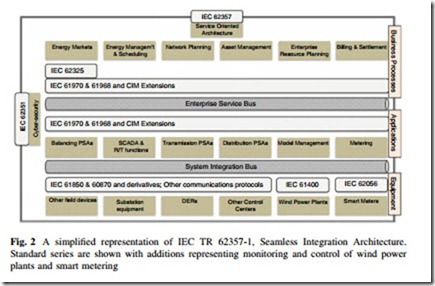Smart Grid Standards Architecture
In [16] NIST identify 75 existing standards and 15 high-priority gaps in support of smart grid interoperability, in addition to cyber-security issues, as a starting point for standards development and harmonization by standards setting and development organizations. Sixteen Priority Action Programs (PAPs) have been initiated by NIST to address areas in which standards need revision or development to complete the standards framework according to their smart grid vision. The IEC Standardization Management Board of Technical Committee (TC) 57 identified over 100 standards and standard parts in a strategic review of power system information exchange [51]. Both of these studies concluded however, that only a small number of standards lie at the core of smart grid interoperability and they can be organized into a corresponding layered reference architecture described in IEC/TR 62357 [52]. This reference SOA shows how these standards relate to each other, require harmonization and presents the gaps where further standards development work is required. In general all standards setting and development organizations advocate a collaborative approach to the development of open standards for the smart grid, with the reuse of existing standards as far as possible.
Rohjans et al. in [53, 54] conduct global surveys of smart grid standardization studies and confirm that the IEC/TR 62357 standard, also known as the ‘‘Seamless Integration Architecture’’ (SIA), represents a general consensus of what are the core smart grid standards, subject to two additional standards. These are IEC 61400-25 series: Communications and Monitoring for Wind Power Plants and IEC 62056: Companion Specifications for Energy Metering (COSEM). In Fig. 2, the standards groups included in the IEC SIA and the additions recommended above are shown in simplified form to support the smart grid organizational architecture of Fig. 1. The cross-cutting issue relating to cyber-security is addressed by the standards group on the left hand side of Fig. 2. The evolution of IEC/TR 62357 reflects the broadening scope of TC 57 in step with smart grid use cases from its original charter of ‘‘Power System Control and Associated Telecommunications’’ to ‘‘Power System Man- agement and Associated Information Exchange.’’ Generally this change reflects the shift in emphasis from lower level interconnection protocols to abstract information models in the higher levels of the architecture as the number of business functions needing to interoperate with PSAs has increased with smart grid evolution. The TC57 architecture generally follows the form of the GWAC Stack layers 1–7, as it ascends from standards concerned with communications relating to the connec- tivity of field devices through to information exchanges to support business processes and enterprise objectives. Due to the wide range of perspectives upon what is a smart grid from the countries surveyed, maintenance of the SIA as a central reference is a priority to keep abreast of smart grid evolution. Recommended initial work to extend the SIA would include CIM standards for DER and the increasing number of CIM profiles, electric mobility, and charging, as well as relevant stan- dards referring to the OPC UA.
The middle layers of the GWAC Stack are in transition from a technical to an organizational focus requiring information interoperability. These ‘‘Informational’’ layers correspond to ‘‘Business Context’’ and ‘‘Semantic Understanding.’’ They align with the CIM standards IEC 61970, IEC 61968 in IEC/TR 62357. In IEC/TR 62357-1 [55], a further standard, IEC 62352, is added to the CIM. These standards make up the current specification for the IEC Common Information Model (CIM) and broadly apply to the functions of EMS application integration, distribution system application integration and energy market system communications inte- gration respectively. Their importance has been described by NIST as central to
the foundations of smart grid interoperability [56]. The specific designations for the CIM standards are IEC 61970-301, IEC 61968-11, and IEC 62325-301. Recent development of IEC 62325 to suit a European energy market context is ongoing and a finished extension to this standard is expected to be published by the IEC in 2014.
The EU Task Force for Smart Grids, Expert Group 1, have analyzed smart grid interoperation from the three perspectives of Transmission, Distribution, and Home, and have also summarized international standards harmonization initiatives in [57]. Their standardization methodology recommends a top-down approach with three levels, taking into account Mandate M/441 to ensure that smart metering is included in wider smart grid application standards. The three levels are as follows:
• Harmonize smart grid use cases in member states.
• Harmonize smart grid data modeling and description language.
• Harmonize communication protocols.
A further significant standards framework in support of a SIA is the Institute for Electrical and Electronic Engineers (IEEE) Smart Grid Interoperability Reference Model (SGIRM) [58], which addresses interaction between the actors within the 7 domains identified in the NIST Conceptual Architecture Framework. Its focus is upon interface architectures and data flow characteristics from three architectural perspectives: communications, power systems, and information technology plat- forms. It provides a scalable model of functional interoperability that can be extended as the scope of the smart grid evolves.
